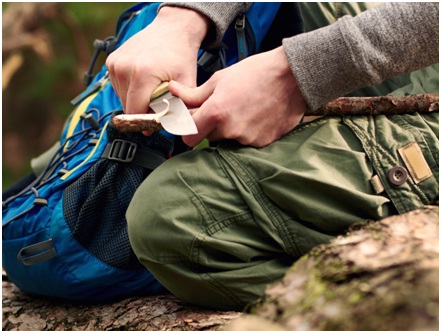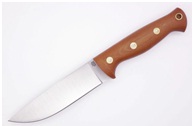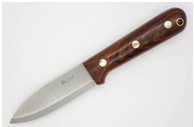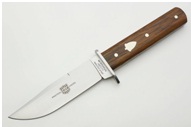What To Look For When You Buy A Camping Knife
Dec 14 2020 - 2:23

Serious campers know just how essential a good knife can be. Whether you are planning a late season camping trip or just stocking up on supplies for spring, it is never a bad time to buy a camping knife. We have a huge selection of knives that would make the perfect addition to any camping pack and our team has even curated a selection of knives that we love into the “Camping Knives” section of our store. If you need a little help making a decision, today we are going over a few things to consider to ensure that your knife will be the perfect fit for your next camping trip.
Camp Knife Overview
A good knife is an important tool around the campsite because the right knife can accomplish a wide variety of tasks. Obviously the kinds of jobs that you will need a knife to tackle will vary widely depending on how you camp. If you are trying to hone your survival skills and build a campsite from scratch, then your knife is going to do a lot of work. If you are going to take a trip in a fully stocked camper, you are still going to need a good knife for smaller jobs, especially when you are away from the conveniences of your campsite.
Folding Vs. Fixed
When it comes to knives, one of the biggest factors in terms of performance is whether you have a fixed blade or a folding blade. Some users love the utility of a folding blade. You can slip it in your pocket and whip it out whenever it is needed. Despite this convenience, there are always going to be some who argue that a folder is just pre-broken and you should always go for a fixed blade option. Ultimately it comes down to what works best for you, but it's always good to look at both sides of the coin.
Also any knife worth its salt can perform simple camping tasks. If you only need to cut some cordage, open up packs of food, or sharpen a stick to roast a marshmallow, then you probably won’t be lost if you don’t have a sturdy fixed blade hanging from your hip. A small fixed blade or a folding knife can easily accomplish these jobs. Smaller knives also make great everyday carry options for anyone who is looking for a useful knife to have by their side whenever they need one.
There are plenty of campsite chores that will be beyond the capabilities of your average folding knife. You will definitely have to deal with some of these more intense tasks if you plan on practicing bushcraft on your trip. This includes chopping wood for shelter building or batoning firewood. Having the right knife with you will ensure that you can handle any job you might encounter around your campsite.
Size
The jobs you will have to complete are going to have a direct impact on the blade size that you will need. This is a pretty straightforward concept that is essentially a trade off between two factors: control and power. Smaller blades will offer incredible control for performing fine tasks, while a larger blade is going to offer plenty of chopping power.
In most cases, campers should be looking for a blade that will offer the best of both worlds. A good camping knife for all around use should have a blade size somewhere around 3” to 6” is going to offer the most utility. You can choke up on the handle when you need to perform fine tasks or get a sturdy grip and put some power behind your swing to chop limbs and saplings. With the right sized knife and the right bushcraft skills, you should be able to build your entire campsite from scratch.
Blade design
The blade is the most important part of the knife and it will have the most impact on how it performs. There are a lot of different schools of thought when it comes to what factors make the best blade when you are looking to buy a camping knife. While we cannot provide a definitive answer on which blade style is the best, we can go over a few of the most popular blade styles and their strengths and weaknesses.

●Drop Point - A drop point is widely considered one of the most versatile blade designs. The spine curves down from edge to the point of the blade. The blade itself also features a belly that makes it great for slicing. The point of the blade is strong and well suited for performing fine cuts, which is one of the reasons why many EDC folding knives feature this point design.

●Spear Point - The spear point has a symmetrical design that produces an extremely strong point. The belly is somewhat less pronounced, but still has a curvature that slices well. Typically one one side of the blade is sharpened, leaving a slightly heavier spine, though these knives are exceptionally well balanced. With the point of the blade being quite pronounced, it performs very well for drilling and piercing tasks.

●Clip point - One of the “classic” knife designs, the clip point is a traditional choice for hunters and other outdoorsmen. The spine is typically relatively straight for approximately half the length of the blade, after which it begins to slope down to meet a sharp point. The knife has a sufficient belly and its sharp point makes the clip point an excellent choice for piercing tasks.

●Nessmuk - The Nessmuk might not be one of the most common knife designs, but they are worth considering if you are looking to buy a camping knife. These knives typically have both a deep curved belly and a slight upward curve to the spine. This creates a large blade that is sturdy and well suited for slicing. It has only a slight point, so it may not be the best option for piercing, but the Nessmuk remains a great knife for camping and hunting.
Materials
Once you know what kind of blade style you prefer, you need to think about what material is being used to construct that blade. There are virtually limitless types of steel and many varieties make excellent knives. Like everything else in the realm of knives, there are some diehard fans of certain types of steel and others who claim that the right materials are application specific. The two main types of steel used to make knives are carbon steel and stainless steel.
●Carbon Steel - All steel is an alloy of iron and carbon, but carbon steel is a title given to alloys with a larger percentage of carbon than most. Carbon steel is extremely strong, making it a great candidate for knife making. This strength also makes carbon steel slightly harder to bend and manipulate, which is another point in its favor for knifemakers. One disadvantage of using carbon steel is the fact that it can rust, meaning that a poorly maintained blade may begin to oxidize. 1095 and A2 carbon steels are two very common varieties used in knifemaking.
●Stainless Steel - Stainless steel alloys are alloys that contain chromium. The chromium content helps to produce a “passive film” on the surface of the blade that resists oxidation and self restores. To be considered a stainless steel alloy, steel should contain at least 11% chromium. Metals with less Chromium are sometimes called semi stainless steel due to their increased resistance to corrosion over conventional steel alloys. Stainless steel blades are great because they can be exposed to the elements with less risk of damage. Typically it will take a little more time to put a sharp edge on a stainless steel knife than a carbon steel and it will dull quicker.
Handles
Okay, we have talked all about the blade but now let’s look at some of the other components to consider when you buy a camping knife. Once you have a quality blade, you are going to want a nice handle to go with it. The handle is the means by which we interact with our knives and the main options are natural and composite materials. A lot of this decision will come down to aesthetics, but there are also some material considerations to make.
●Natural Handles - Natural handle materials include wood, bone, and leather. These materials have been used in knifemaking for thousands of years and with good reason. Natural handle materials provide a unique look and feel that can be modern or timeless. One downside of these natural materials is the fact that they sometimes require a little maintenance, though this is barely an issue. If a wooden handle looks too dry or worn, then all it needs is a little oil or wax and it will be looking like new again.
●Composite Handles - The popularity of modern materials like plastics and epoxy resins have revolutionized the production of knife handle scales. By laying sheets of materials like paper, fiberglass, and cloth impregnated with epoxy resin, composite materials can be made for the production of knife handles. Micarta, G10, and carbon fiber handle scales are all produced in this fashion. The resulting handle scales are extremely strong and water resistant. They can also be uniquely colored and textured to give your knife a distinct look.
Sheaths
Now that you know what kind of blade and handle you want, you should be able to find the perfect knife to fit your needs. Now you need to think about how you will transport that knife. A good sheath is a great way to keep your blade and yourself safe wherever your trip takes you. The first factor to consider when choosing a sheath is how you want to carry that sheath.
Some users prefer a sheath that attaches directly to their belt while others will prefer dangling knife systems that will swing freely while you walk, allowing extra freedom of movement. Once you know the sheath system that you prefer, you can look into different material options. Leather sheaths are always a popular choice. They are soft, flexible, and quiet but they may require occasional oiling just like a natural knife handle.
The other option is to use synthetic sheaths. Woven Nylon sheaths are similar to leather in terms of performance, albeit with a slightly more tactical appearance. Plastic sheaths are another option, though they can warp over time. If you want a secure synthetic sheath, a molded Kydex option might be the best choice. These sheaths are made from hard thermoplastic polymer sheets that are heated and molded around knives to provide a secure fit. They are rigid and can often be combined with MOLLE sheath systems, though they can also be a little louder than a leather sheath.
Knife Builder
If you want a little more versatility over your camping knife than an off the shelf option provides, you can put together your own knife package using our exclusive Knife Builder tool. All you have to do is choose a knife model that you like and start choosing features and accessories. Our Knife Builder features high quality knife models from ESEE Knives, the Ontario Knife Company, and our own Architect brand. Once you have found a model you will be able to choose options including blade coatings, handle scale colors, sheath systems, and other accessories like fire starters to go with your new knife.
Whether you want to put together your own knife or buy a camping knife from a huge inventory of options, we are the shop for you. If you have any questions about any of our products, our team of knife experts is always happy to help. Just send an email support@theknifeconnection.com and we will help you find the perfect camping knife for your next trip!